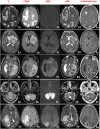Diagnostic challenges and treatment breakthroughs in Malassezia restricta-induced meningoencephalitis: a real-world analysis of early mNGS applications
- PMID: 40756029
- PMCID: PMC12313642
- DOI: 10.3389/fcimb.2025.1613521
Diagnostic challenges and treatment breakthroughs in Malassezia restricta-induced meningoencephalitis: a real-world analysis of early mNGS applications
Abstract
Background: Malassezia restricta is a lipid-dependent yeast species that commonly colonizes human and warm-blooded animal skin as an opportunistic pathogen. Although strongly associated with dermatological conditions like seborrheic dermatitis, central nervous system (CNS) infections caused by Malassezia restricta are remarkably rare. These infections typically present with nonspecific clinical features, leading to frequent diagnostic delays and misdiagnosis.
Methods: We performed a retrospective analysis of five definitive cases of Malassezia restricta-induced meningoencephalitis diagnosed at our institution. Comprehensive clinical evaluations included disease onset patterns, symptomatology, laboratory findings, neuroimaging features, therapeutic regimens, and patient outcomes.
Results: All patients exhibited acute onset meningoencephalitis, with headache being the most common presentation symptom, and patients presenting with decreased consciousness showed rapid clinical deterioration. Brain magnetic resonance imaging (MRI) exhibits ring enhancement accompanied by ring diffusion restriction, plays a crucial role in early diagnosis. The cerebrospinal fluid (CSF) demonstrated markedly elevated intracranial pressure and a significant decrease in CSF glucose, vital laboratory markers of critical illness. Metagenomic next-generation sequencing (mNGS) of CSF confirmed Malassezia restricta infection in all cases, enabling prompt diagnosis. Early combination therapy with intravenous and intrathecal antifungal agents significantly improved survival outcomes.
Conclusion: Malassezia restricta-associated meningoencephalitis represents an extremely rare and life-threatening CNS infectious disease. Since nonspecific early symptoms lead to diagnostic challenges, CSF usually shows a significant increase in intracranial pressure, and a significant decrease in CSF glucose levels may serve as a key laboratory biomarker. Brain MRI demonstrates multiple and diverse intracranial lesions, with ring enhancement accompanied by ring diffusion restriction potentially representing relatively specific imaging features. mNGS of CSF may prove valuable for early diagnosis. Standardized antifungal therapy, particularly early intrathecal administration, may be critical to reducing mortality.
Keywords: Malassezia; Malassezia restricta; diagnostic challenges and treatment breakthroughs; meningoencephalitis; metagenomic next-generation sequencing.
Copyright © 2025 Wang and Tao.
Conflict of interest statement
The authors declare that the research was conducted in the absence of any commercial or financial relationships that could be construed as a potential conflict of interest.
Figures
Similar articles
-
Diagnosis of invasive pulmonary aspergillosis using metagenomic next-generation sequencing and conventional microbial tests post-COVID-19 pandemic.Microbiol Spectr. 2025 Jul;13(7):e0012125. doi: 10.1128/spectrum.00121-25. Epub 2025 Jun 9. Microbiol Spectr. 2025. PMID: 40488474 Free PMC article.
-
The Black Book of Psychotropic Dosing and Monitoring.Psychopharmacol Bull. 2024 Jul 8;54(3):8-59. Psychopharmacol Bull. 2024. PMID: 38993656 Free PMC article. Review.
-
Uncommon Non-MS Demyelinating Disorders of the Central Nervous System.Curr Neurol Neurosci Rep. 2025 Jul 1;25(1):45. doi: 10.1007/s11910-025-01432-8. Curr Neurol Neurosci Rep. 2025. PMID: 40591029 Review.
-
Citrullinemia Type I.2004 Jul 7 [updated 2022 Aug 18]. In: Adam MP, Feldman J, Mirzaa GM, Pagon RA, Wallace SE, Amemiya A, editors. GeneReviews® [Internet]. Seattle (WA): University of Washington, Seattle; 1993–2025. 2004 Jul 7 [updated 2022 Aug 18]. In: Adam MP, Feldman J, Mirzaa GM, Pagon RA, Wallace SE, Amemiya A, editors. GeneReviews® [Internet]. Seattle (WA): University of Washington, Seattle; 1993–2025. PMID: 20301631 Free Books & Documents. Review.
-
Clinical Metagenomic Sequencing for Diagnosis of Meningitis and Encephalitis.N Engl J Med. 2019 Jun 13;380(24):2327-2340. doi: 10.1056/NEJMoa1803396. N Engl J Med. 2019. PMID: 31189036 Free PMC article. Clinical Trial.
References
-
- Alameer R. M., Tayeb H., Magrashi A., Alqasabi A., Nazmi A., Yamani A., et al. (2025). Diagnosis of donor-derived Malassezia restricta &Aspergillus species invasive fungal infection in renal transplant recipient using next generation sequencing - A report of 2 cases and literature review. J. Infect. Public Health 18, 102742. doi: 10.1016/j.jiph.2025.102742, PMID: - DOI - PubMed
-
- Arendrup M. C., Boekhout T., Akova M., Meis J. F., Cornely O. A., Lortholary O., et al. (2014). ESCMID and ECMM joint clinical guidelines for the diagnosis and management of rare invasive yeast infections. Clin. Microbiol. Infect. 20 Suppl 3, 76–98. doi: 10.1111/1469-0691.12360, PMID: - DOI - PubMed
Publication types
MeSH terms
Substances
LinkOut - more resources
Full Text Sources


